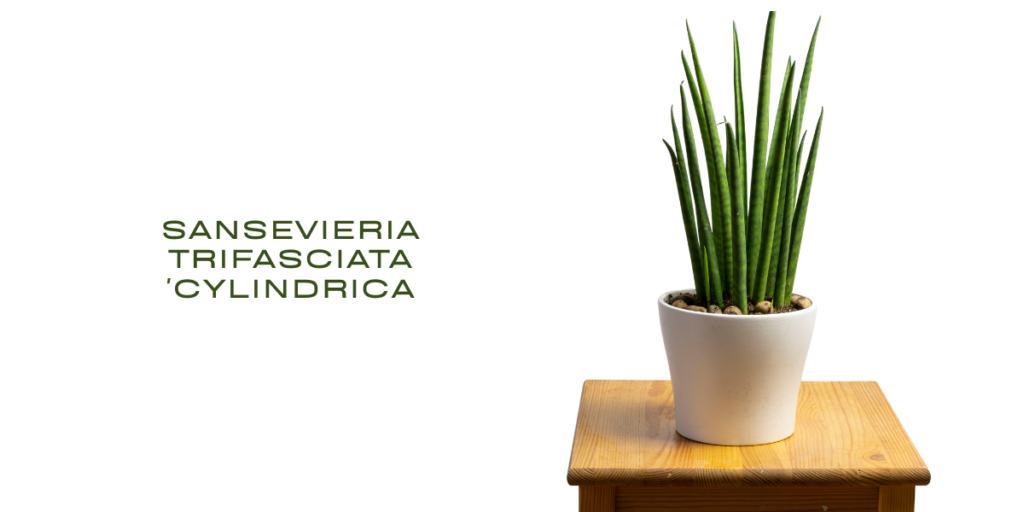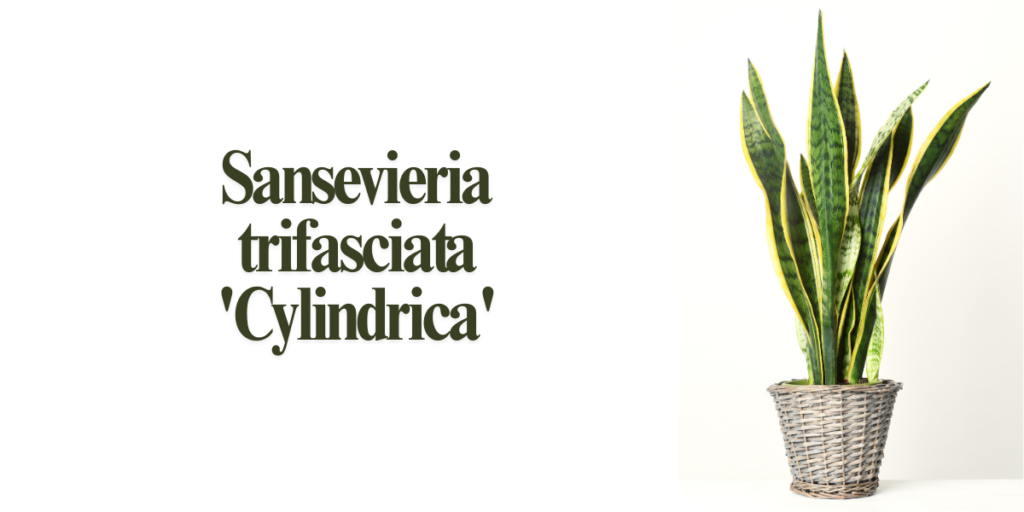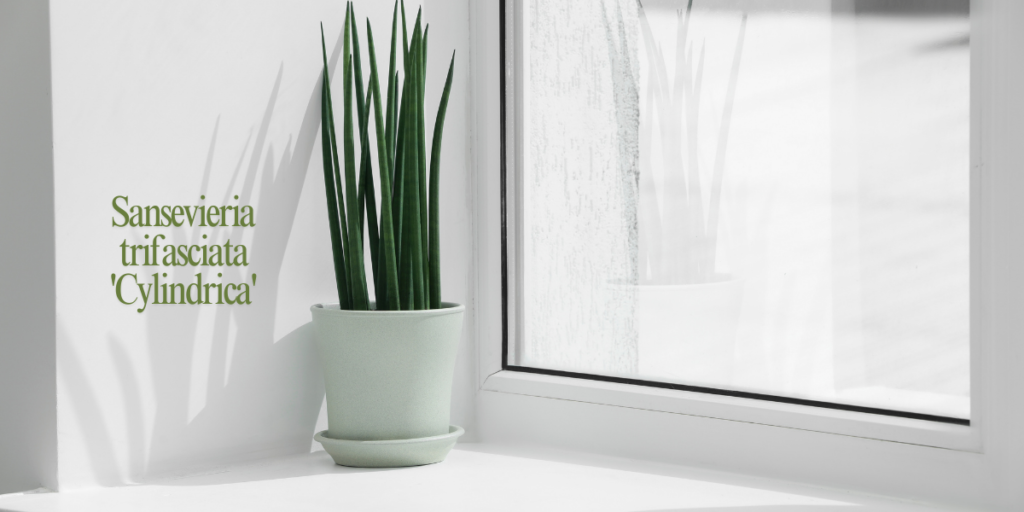Sansevieria trifasciata ‘Cylindrica’: Care Guide, Benefits, and Tips for Growth
Sansevieria trifasciata ‘Cylindrica’, commonly known as the Cylindrical Snake Plant or African Spear Plant, is a remarkable member of the Sansevieria genus, renowned for its unique appearance and low-maintenance nature. With its tall, upright cylindrical leaves, this plant adds a modern aesthetic to any indoor space, making it a popular choice among houseplant enthusiasts. Beyond its striking visual appeal, the ‘Cylindrica’ is celebrated for its air-purifying properties, resilience, and adaptability, ensuring it remains a favored option for both seasoned gardeners and beginners alike.
Overview and Key Features of Sansevieria trifasciata ‘Cylindrica’

Sansevieria trifasciata ‘Cylindrica’ is characterized by its robust, cylindrical leaves that can grow anywhere from 3 to 4 feet tall, depending on the growing conditions. The leaves are a vibrant green, often highlighted with lighter green vertical stripes that add depth and texture.
Key Features:
- Unique Leaf Structure:
- The plant’s spear-like leaves grow upright and can have a slightly twisted appearance, creating a sculptural quality that enhances any decor. The leaves can vary in thickness, contributing to their striking presence. In a cluster, they form a rosette that can spread outwards, creating an eye-catching display.
- Air-Purifying Qualities:
- Sansevieria trifasciata ‘Cylindrica’ is known for its ability to improve indoor air quality. NASA’s Clean Air Study highlighted various plants, including Snake Plants, for their air-purifying capabilities. The plant helps filter common indoor pollutants like formaldehyde, xylene, and benzene, making it a great addition to homes, offices, and indoor spaces where air quality is a concern.
- Low Maintenance:
- One of the most appealing aspects of the ‘Cylindrica’ is its minimal care requirements. This plant thrives on neglect, making it perfect for busy individuals or those new to plant care. Its drought tolerance means it can go weeks without water, and its hardiness allows it to endure a range of environmental conditions.
- Adaptability:
- The Cylindrical Snake Plant is versatile in its growing conditions. It can be kept as a houseplant, thriving in pots indoors, or planted directly in the ground in warmer climates. Its ability to adjust to different light levels and environments makes it a favorite among plant collectors.
Natural Habitat and Origins of with Sansevieria trifasciata ‘Cylindrica’
Sansevieria trifasciata ‘Cylindrica’ originates from the arid regions of West Africa, particularly in countries like Nigeria. In its native habitat, it grows in rocky, dry soils, showcasing its adaptability to harsh conditions.
Adaptations:
- Drought Resistance:
- The thick, fleshy leaves are designed to store water, enabling the plant to survive long periods of drought. This characteristic is particularly beneficial in indoor environments, where water availability can fluctuate.
- Waxy Cuticle:
- A natural waxy coating on the leaves serves to reduce moisture loss, protecting the plant from dehydration. This feature not only helps the plant retain water but also contributes to its glossy appearance, making it visually appealing.
Ideal Growing Conditions for with Sansevieria trifasciata ‘Cylindrica’
Providing the right growing conditions is crucial for the health and vitality of your Sansevieria trifasciata ‘Cylindrica’.
Light Requirements:
- Bright, Indirect Light:
- The ‘Cylindrica’ thrives best in bright, indirect light, such as that found near a north or east-facing window. This allows the plant to grow vigorously without the risk of leaf burn. In lower light conditions, it can still survive, but its growth may slow, and the plant may become leggy as it stretches towards available light.
- Avoid Direct Sunlight:
- While it can tolerate some direct sun, prolonged exposure can lead to leaf scorch, manifesting as brown, crispy edges. If you notice these symptoms, consider relocating the plant to a spot with filtered light or a few feet away from a sunny window.

Watering:
- Infrequent Watering:
- One of the key aspects of caring for the ‘Cylindrica’ is to avoid overwatering, as this is one of the most common mistakes made by indoor gardeners. The rule of thumb is to water only when the top inch of soil feels dry to the touch. Depending on the humidity and temperature of your home, this typically means watering every 2-4 weeks. In winter, the plant requires even less frequent watering due to lower light and cooler temperatures.
- Well-Draining Soil:
- A well-draining potting mix is essential to prevent water from accumulating around the roots. A cactus or succulent mix is ideal, or you can create your own by combining regular potting soil with sand or perlite to enhance drainage.
Temperature and Humidity:
- Temperature Range:
- The optimal temperature for Sansevieria trifasciata ‘Cylindrica’ falls between 65°F and 80°F (18°C to 27°C). This range mimics its native tropical climate. It can tolerate higher temperatures, but exposure to cold drafts or temperatures below 50°F (10°C) can stress the plant and lead to damage.
- Humidity:
- This plant thrives in low humidity environments, making it well-suited for typical indoor conditions. While it can tolerate higher humidity levels, it does not require them to flourish. Excessive humidity can increase the risk of fungal issues, so it’s best to maintain moderate humidity levels.
Common Issues and Solutions for Sansevieria trifasciata ‘Cylindrica’
Even the hardiest plants can face challenges. Here are some common issues you may encounter with Sansevieria trifasciata ‘Cylindrica’ and how to address them.
Overwatering:
- Symptoms:
- The most common sign of overwatering is yellowing leaves, which may start to feel soft or mushy. Roots may also begin to rot, leading to a foul smell from the soil.
- Solution:
- If you think the plant has been overwatered, pause watering right away and let the soil dry. If root rot appears, carefully take the plant out of its pot, trim any affected roots, and replant it in fresh, dry soil. Modify your watering routine to allow the soil to dry out between waterings.
Underwatering:
- Symptoms:
- Leaves may develop brown, crispy edges or tips, which indicates that the plant is not receiving enough moisture. In extreme cases, the leaves may begin to droop or shrivel.
- Solution:
- Increase your watering frequency, ensuring that you provide sufficient water to thoroughly soak the soil. Adjust your routine based on environmental conditions—more frequent watering may be necessary during hotter months.
Pests:
- Common Pests:
- Sansevieria trifasciata ‘Cylindrica’ can occasionally attract pests such as mealybugs, spider mites, and aphids. These pests can harm the plant, causing it to weaken and experience stunted growth..
- Solution:
- Frequently check the undersides of leaves for any signs of pests. If you find an infestation, treat it promptly with insecticidal soap or neem oil. Wiping down the leaves with a damp cloth can help deter pests and keep the plant clean.
Propagation Methods for Sansevieria trifasciata ‘Cylindrica’
Sansevieria trifasciata ‘Cylindrica’ is relatively easy to propagate, allowing you to expand your collection or share with friends.
Leaf Cuttings:
- Select Healthy Leaves:
- Choose mature leaves from a healthy parent plant. The best time to take cuttings is during the growing season in spring or summer.
- Cut into Sections:
- Using a clean, sharp knife or scissors, cut the leaves into sections about 4-6 inches long. Ensure that each cutting has a base that was originally attached to the plant.
- Callus Formation:
- Allow the cuttings to dry in a warm, shaded area for a day or two. This helps form a callus over the cut ends, reducing the risk of rot when they are planted.
- Planting:
- After the cut ends have callused, plant them upright in a well-draining potting mix, ensuring the cut end is buried about an inch deep. Water lightly to settle the soil and keep the soil slightly moist until roots develop, which usually takes a few weeks.
Division:
- Remove the Plant:
- Carefully take the plant out of its pot, being gentle with the roots to minimize damage.
- Separate Offsets:
- Look for offsets (pups) that have developed around the base of the parent plant. These should have roots of their own, making them suitable for replanting. Use a clean knife to cut the pups away from the main plant.
- Potting:
- Re-pot each offset into its own container filled with fresh potting mix. Water gently to help compact the soil around the roots.
Pet Safety and Toxicity Concerns

While Sansevieria trifasciata ‘Cylindrica’ is beloved for its beauty and resilience, it’s important to be aware of its toxicity to pets.
Toxicity Levels:
- Mildly Toxic:
- The plant contains saponins, which can cause gastrointestinal upset if ingested by pets, particularly dogs and cats. Symptoms may include vomiting, diarrhea, and nausea.
Keeping Pets Safe:
- Placement:
- To keep your furry friends safe, position the plant in an area that is not easily accessible to them. Hanging pots or high shelves can be ideal solutions.
- Veterinary Consultation:
- If you think your pet has eaten any part of the plant, reach out to your veterinarian right away. They can provide advice and treatment options based on the situation.
General Questions about Sansevieria trifasciata ‘Cylindrica’
- What is the common name for Sansevieria trifasciata ‘Cylindrica’?
- It is commonly referred to as the Cylindrical Snake Plant or African Spear Plant due to its unique leaf shape and origin.
- Is Sansevieria trifasciata ‘Cylindrica’ safe for pets?
- While it is considered mildly toxic, it’s advisable to keep it out of reach of pets to prevent ingestion.
- How often should I water my Cylindrical Snake Plant?
- Water only when the top inch of soil is dry; typically every 2-4 weeks, depending on the environmental conditions.
- Can I propagate my Sansevieria trifasciata ‘Cylindrica’?
- Yes, it can be propagated easily through leaf cuttings or division of offsets.
- What light conditions are best for this plant?
- It prefers bright, indirect light but can also tolerate low-light conditions, making it versatile for various indoor settings.
Conclusion
Sansevieria trifasciata ‘Cylindrica’ is more than just a pretty plant; it’s a hardy, adaptable species that enhances indoor spaces while improving air quality. With its unique, spear-like leaves and minimal care requirements, it is an ideal choice for anyone looking to introduce greenery into their home or office. By following the comprehensive care tips outlined in this guide, you can enjoy the beauty and benefits of this resilient houseplant for years to come.










Post Comment